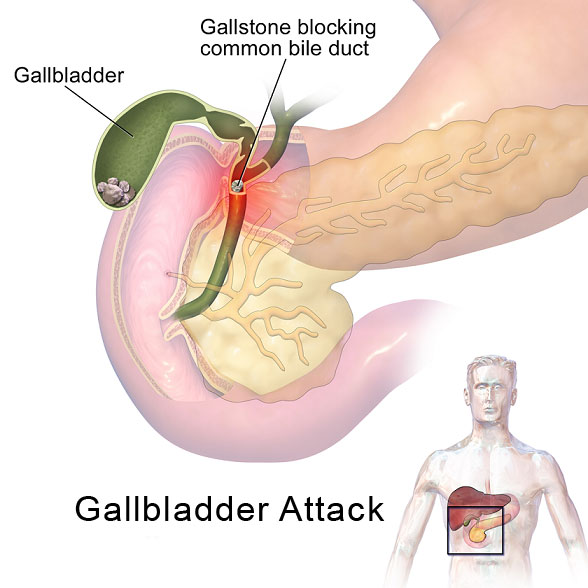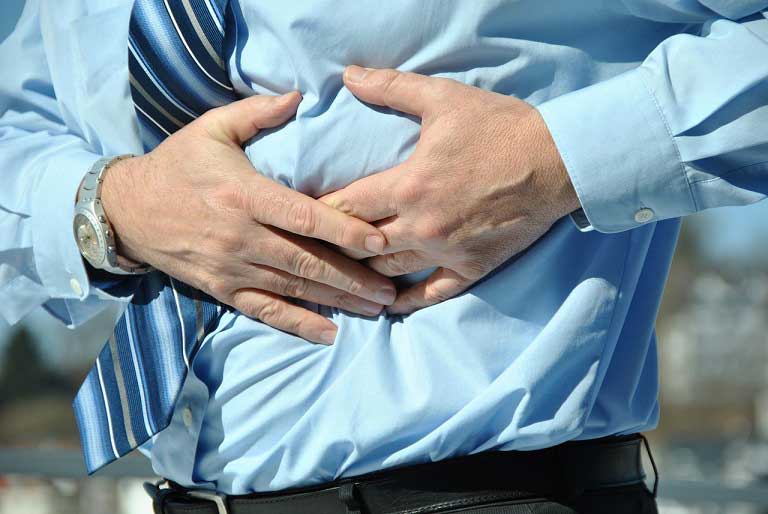Ever heard someone having a Gallbladder Attack and wondered what is it? Keep reading the article to understand more.
Before talking about a gallbladder attack, knowing the anatomy of gallbladder and the meaning of a couple of related terms will help in a better understanding of the concept. The gallbladder is an organ located in the upper right abdomen. The liver is connected to the gallbladder, which in turn is connected to the small intestine through narrow tubes called bile ducts. The gallbladder holds half of the bile secreted by the liver. Bile is a thick green, yellow, or brown coloured liquid that helps in the digestion of fatty food. Once you eat a heavy meal, the gallbladder squeezes and bile is released to the small intestine through the ducts and thereby helping in the digestion.

Gallbladder Attack
Also known as gallstone attack, cholecystitis, or biliary colic, it is a condition when bile cannot move out of the gallbladder due to various reasons. This causes inflammation and irritation in the gallbladder, which gives rise to an attack of sporadic pain in the right side of the stomach.
What causes a Gallbladder Attack?
Gallstones– Most commonly it happens due to blocking of the bile ducts from ‘gallstones’. Gallstones are hard, stone-like materials made of cholesterol present in the bile. They usually vary in size from 5mm to as large as more than 2cm. This condition is also referred to as cholecystitis, it can be chronic- due to long-lasting inflammation and damage to the gallbladder and acute- sudden “attack” that causes irritation and swelling.
Having said that, there are also other conditions causing a gallbladder attack which are not due to the reason mentioned above. Here are some other health issues causing a gallbladder attack:
Acalculus cholecystitis- As the name suggests, this is an inflammatory disease of gallbladder without the presence of gallstones. This is usually a result of a surgery or long term starvation.
Ascending cholengitis- Here, the bile duct gets inflamed because of the bacteria ascending from the small intestine.
Symptoms of Gallbladder Attack
- Pain: Abdominal pain is the main symptom of a gallbladder attack. The pain usually starts in the right-section of the upper stomach. Generally, the pain will be sudden and sharp. Sometimes the pain radiates to the right shoulder. Some people might also experience back pain.
- Vomiting: Nausea and vomiting are pretty common symptoms of a gallbladder attack
- Jaundice: In some cases, people also experience yellowing of the skin and eyes.
While these are the main signs of a gallbladder attack, some of the uncommon symptoms are-
- Tea-colored urine
- Fever and chills
- Tender abdomen
- Pain after eating a meal
- Bloated stomach
- Long time constipation
What triggers a Gallbladder Attack?
Heavy meal: When you eat a heavy meal, especially fatty food, your gallbladder contracts to release bile to the small intestine. Because the bile ducts are blocked and stop the flow of bile fluid, it creates pressure in the gallbladder and results in an attack.
How long does a Gallbladder Attack Last?
An acute attack usually lasts from 15 min to more than six hours. A chronic attack is defined by the recurrence of pain repeatedly.
How to stop a Gallbladder Attack while it’s Happening?
- Hot compression: Applying heat on the painful area can help relieve the spasms. So, use a hot water bag, or a bottle filled with hot water to temporarily ease the pain.
- Peppermint tea: Peppermint contains menthol, which has soothing properties. It is often used to ease pain, improve digestion, and reduce nausea.
- Apple cider vinegar: Apple cider vinegar is understood to possess anti-inflammatory properties. Hence, it might help soothe stomach pain.
- Magnesium: Drinking water mixed with magnesium powder, once in a few hours can help in emptying the gallbladder and reduce the pain.
How to prevent a Gallbladder Attack?
Prevention is always better than cure. Is there any way to prevent this attack from occurring? Definitely! Like every other disease, lifestyle is the key.
Weight: Maintain a healthy weight as obesity increases the risks of gallstone formation.
Exercise: As mentioned, cholesterol in bile forms gallstones, and a sedentary lifestyle increases cholesterol in the body. So, make exercise, a part of your daily routine.
Diet: Make sure to eat nutritious food rich in fiber, include vegetables and fruits in your daily meals. A study shows psyllium husks to be good for gallbladder health. And avoiding fatty, oily, junk food items and processed carbohydrates is a must!
Treatment for Gallbladder Attack
Most of the time, gallstones are known to go away naturally. But, if the symptoms persist, it’s important to seek medical help. Although some studies suggest natural remedies like yoga, milk thistle, artichoke, etc for treating the disease, there is no proven research on home remedies for a gallbladder attack.

The most common method to diagnose the problem is an ultrasound scanning of the abdominal area. Other methods are abdominal X-ray, CT scan, and liver function blood test.
Medication: Sometimes for an acute attack, ibuprofen is given to ease the pain. The most commonly used drug is ‘ursodiol’ (also called ursodeoxycholic acid). This is an oral drug, which helps to dissolve the gallstones. However, it has to be consumed for an extended period to observe its effects.
Surgery: The usual method to treat a gallbladder attack is to remove the gallbladder by a surgery called cholecystectomy. Though gallbladder is an important organ in our body, a person can lead a normal life without it. Cholecystectomy can either be an open surgery or a keyhole surgery.
Some other surgeries are performed to remove the gallstones and the extra bile. Endoscopic retrograde cholangiopancreatography (ERCP) is a method where an endoscope attached to a small camera is inserted into the stomach through the mouth, and remove the gallstones. Percutaneous cholecystostomy tube is also a gallbladder drainage method which is done through a tiny cut in the stomach.
Summary
The gallbladder has an important role in digesting food. By maintaining a healthy diet and active lifestyle, the chances of a gallbladder attack can be reduced. However, the risk factors are high for females, people aged above 40, and with a family history of a gallbladder problem. If you are experiencing the symptoms, do contact your physician instead of self-medicating.
